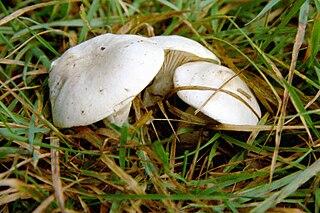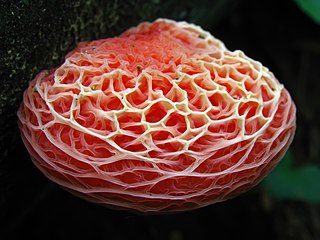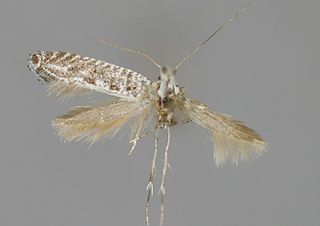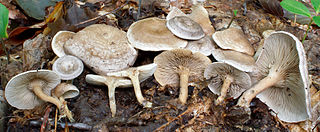Related Research Articles

The giant panda, sometimes called a panda bear or simply panda, is a bear species endemic to China. It is characterised by its bold black-and-white coat and rotund body. The name "giant panda" is sometimes used to distinguish it from the red panda, a neighboring musteloid. Though it belongs to the order Carnivora, the giant panda is a folivore, with bamboo shoots and leaves making up more than 99% of its diet. Giant pandas in the wild occasionally eat other grasses, wild tubers, or even meat in the form of birds, rodents, or carrion. In captivity, they may receive honey, eggs, fish, yams, shrub leaves, oranges, or bananas along with specially prepared food.

Entoloma sinuatum is a poisonous mushroom found across Europe and North America. Some guidebooks refer to it by its older scientific names of Entoloma lividum or Rhodophyllus sinuatus. The largest mushroom of the genus of pink-spored fungi known as Entoloma, it is also the type species. Appearing in late summer and autumn, fruit bodies are found in deciduous woodlands on clay or chalky soils, or nearby parklands, sometimes in the form of fairy rings. Solid in shape, they resemble members of the genus Tricholoma. The ivory to light grey-brown cap is up to 20 cm (7.9 in) across with a margin that is rolled inward. The sinuate gills are pale and often yellowish, becoming pink as the spores develop. The thick whitish stem has no ring.

The Entolomataceae are a family of fungi in the order Agaricales. The family contains eight genera and 2250 species, the majority of which are in Entoloma. Basidiocarps are typically agaricoid, but a minority are cyphelloid. secotioid, or gasteroid. All produce pink basidiospores that are variously angular (polyhedral), ridged, or nodulose. Species are mostly saprotrophic, though a few are parasitic on other fungi. The family occurs worldwide.

Rhodocybe is a genus of fungi in the family Entolomataceae. Basidiocarps are agaricoid producing pink basidiospores that are unevenly roughened or pustular under the microscope. Species are saprotrophic and mostly grow on the ground, occasionally on wood. The genus is distributed worldwide.

Clitopilus prunulus, commonly known as the miller or the sweetbread mushroom, is an edible pink-spored basidiomycete mushroom found in grasslands in Europe and North America. Growing solitary to gregarious in open areas of conifer/hardwood forests; common under Bishop pine along the coast north of San Francisco; fruiting shortly after the fall rains. It has a grey to white cap and decurrent gills.

The baiji is a possibly extinct species of freshwater dolphin native to the Yangtze river system in China. It is thought to be the first dolphin species driven to extinction due to the impact of humans. This dolphin is listed as “critically endangered: possibly extinct” by the IUCN, has not been seen in 40 years, and several surveys of the Yangtze have failed to find it. In China, the species is also called the Chinese river dolphin, Han river dolphin, Yangtze dolphin and whitefin dolphin. Nicknamed the "Goddess of the Yangtze", it was regarded as the goddess of protection by local fishermen and boatmen. It is not to be confused with the Chinese white dolphin or the finless porpoise. This is the only species in the genus Lipotes.

Clitopilus is a genus of fungi in the family Entolomataceae. The genus has a widespread distribution, especially in northern temperate areas. Although a 2008 estimate suggested about 30 species in the genus, a more recent publication (2009) using molecular phylogenetics has redefined the genus to include many former Rhodocybe species.

Rhodotus is a genus in the fungus family Physalacriaceae. There are two species in the genus with the best known, Rhodotus palmatus, called the netted rhodotus, the rosy veincap, or the wrinkled peach. This uncommon species has a circumboreal distribution, and has been collected in eastern North America, northern Africa, Europe, and Asia; declining populations in Europe have led to its appearance in over half of the European fungal Red Lists of threatened species. Typically found growing on the stumps and logs of rotting hardwoods, mature specimens may usually be identified by the pinkish color and the distinctive ridged and veined surface of their rubbery caps; variations in the color and quantity of light received during development lead to variations in the size, shape, and cap color of fruit bodies.

Pleuromutilin and its derivatives are antibacterial drugs that inhibit protein synthesis in bacteria by binding to the peptidyl transferase component of the 50S subunit of ribosomes.

Entoloma abortivum, commonly known as the aborted entoloma or shrimp of the woods, is an edible mushroom in the Entolomataceae family of fungi. Caution should be used in identifying the species before eating. First named Clitopilus abortivus by Miles Joseph Berkeley and Moses Ashley Curtis, it was given its current name by the Dutch mycologist Marinus Anton Donk in 1949.
Stigmella minusculella is a moth of the family Nepticulidae. It is found from Denmark and Latvia to the Pyrenees, Corsica, Italy and Crete, and from Great Britain to Ukraine. It is also present in North America, where it is found in Ohio, New Jersey and Ontario.
Clitopilus byssisedoides is a species of fungus in the family Entolomataceae. It was formally described as new to science in 2010, based on specimens found growing in a greenhouse in Botanischer Garten Jena, in Germany.

Parornix anguliferella is a moth of the family Gracillariidae. It is found from Germany to Sardinia, Sicily and Greece and from the Netherlands to southern Russia.

Rhodocybe gemina is a species of fungus in the family Entolomataceae. It has the recommended English name of tan pinkgill and produces agaricoid basidiocarps that are fleshy and cream when young, becoming brownish when mature.

Clitocybe tarda is a species of mushroom. It has a brownish pink cap with a smooth surface, the flesh is thin and brittle, and the cap tastes bitter. The stalk is slender and smooth. The spore print is pinkish gray. It is unknown if the species is edible, but it does not have a pleasant taste.

Pyrus spinosa, the almond-leaved pear, is a species of flowering plant in the family Rosaceae, native to the northern Mediterranean region. It grows to a height of 3–10 m (10–33 ft). It has white flowers which bloom in April–May. The fruits are bitter and astringent. It hybridizes easily with Pyrus communis and Pyrus pyraster.

Clitocella is a genus of mushroom-forming fungi in the family Entolomataceae. It was circumscribed in 2014 with Clitocella popinalis as the type species. The generic name refers to its similarities and close relationship to the genera Clitopilus and Clitopilopsis; the Latin word cella, meaning "storage place", alludes to "taxa not belonging to Clitopilus or Clitopilopsis". Species have caps with centrally placed stipes; the gills are decurrent, and crowded closely together with a smooth edge. Mushrooms produce a pink spore print. The spores have thin walls that are cyanophilic and surfaces ornamented with minute bumps that can be seen in profile and face views. This surface ornamentation distinguishes Clitocella from Clitopilus, which has longitudinally ridged spores. Clitopilopsis, in contrast, has thicker spore walls.
Gerhardtia is a genus of fungi in the family Lyophyllaceae. It was circumscribed in 1994 by French mycologist Marcel Bon, with Gerhardtia incarnatobrunnea as the type species. It is distinguished from similar genera by having spores with an irregular outline. Some authorities place Gerhardtia in synonymy with Lyophyllum. The New Zealand species Gerhardtia pseudosaponacea, described as new to science in 2014, is similar in appearance to Tricholoma saponaceum, including its weakly soap-like odor.

Rose Marie Dähncke is a German mycologist, and popular author of books on foraging and cooking with foraged foods. She is known for studying the mushrooms of La Palma. She has described at least 14 species of fungi, including several in the genera Cystoderma and Lyophyllum. The standard author abbreviation Dähncke is used to indicate this person as the author when citing a botanical name.
References
- ↑ Zhu L. Yang (2007). "Clitopilus amygdaliformis, a new species from tropical China" (PDF). Mycotaxon. 100: 241–246.